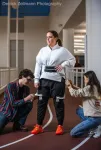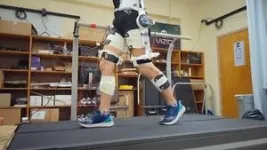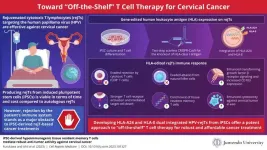(Press-News.org) Robotic Hip Exoskeleton Shows Promise for Helping Stroke Patients Regain Their Stride
A portable robotic device created by UMass Amherst researchers provides new avenue for making state-of-the-art gait rehabilitation methods more effective and accessible
AMHERST, Mass. – More than 80% of stroke survivors experience walking difficulty, significantly impacting their daily lives, independence, and overall quality of life. Now, new research from the University of Massachusetts Amherst pushes forward the bounds of stroke recovery with a unique robotic hip exoskeleton, designed as a training tool to improve walking function. This invites the possibility of new therapies that are more accessible and easier to translate from practice to daily life compared to current rehabilitation methods.
Following stroke, people often experience walking asymmetry, where one step is shorter than the other. The study, published in IEEE Transactions on Neural Systems and Rehabilitation Engineering, reveals that the robotic hip exoskeleton has the potential to effectively train individuals to modify their walking asymmetry, presenting a promising avenue for stroke rehabilitation.
The approach employed by the robotic exoskeleton is inspired by split-belt treadmills, which are specialized machines with two side-by-side belts moving at different speeds. Prior research has shown that repeated training on a split-belt treadmill can reduce walking asymmetry in stroke patients.
Wouter Hoogkamer, assistant professor of kinesiology and author on the paper, has spent the last decade studying split-belt treadmills. “Split-belt treadmill training is designed to exaggerate a stroke patient’s walking asymmetry by running the belts under each foot at different speeds. Over time, the nervous system adapts, such that when the belts are set to the same speed, they walk more symmetrically.”
Unfortunately, there are limits to the benefits gained from treadmill-based training methods. “What is learned on a treadmill does not completely transfer to overground contexts,” says Banu Abdikadirova, mechanical and industrial engineering doctoral candidate and lead study author. “This is because walking on a treadmill is not exactly the same as walking overground.”
“The ultimate goal of gait rehabilitation is not to improve walking on a treadmill – it is to improve locomotor function overground,” says Meghan Huber, assistant professor of mechanical and industrial engineering and senior author on the paper. “With this in mind, our focus is to develop methods of gait rehabilitation that translate to functional improvements in real-world contexts.”
With this motivation, the UMass team sought a novel way to exaggerate walking asymmetry without a treadmill.
This proof-of-concept study showed that applying resistive forces about one hip joint and assistive forces about the other with their exoskeleton mimicked the effects of split-belt treadmill training in neurologically intact individuals.
Now that the research team has proven that the exoskeleton can alter gait asymmetry, they are eager to move their research into overground contexts that are more akin to the real world.
“Because our exoskeleton is portable, it can be used during overground walking,” says Mark Price, a postdoctoral researcher in mechanical and industrial engineering and kinesiology and author on the paper. “We can build upon the successes of split-belt treadmill training with this device to enhance the accessibility of gait training and enhance the transfer of training benefits into everyday walking contexts.”
The researchers also plan to expand their work by measuring the neural changes caused by walking with the exoskeleton and testing this new method on stroke survivors.
“A portable exoskeleton offers numerous clinical benefits,” says Abdikadirova. “Such a device can be seamlessly integrated into the daily lives of chronic stroke survivors, offering an accessible way to increase training time, which is critical for improving walking. It can also be used during early intervention in hospitals for improved functional outcomes.”
The robotic hip exoskeleton is just one of the innovative devices designed to study and enhance gait function developed by the collaborative team of undergraduate students, graduate students, and postdoctoral researchers from the Human Robot Systems Lab, led by Huber, and the Integrative Locomotion Lab, led by Hoogkamer.
“It is inspiring to witness the innovations that emerge when individuals from diverse backgrounds unite under a shared mission,” says Huber. “Only through this type of cross-disciplinary research can we engineer technologies that can have a meaningful impact on people's lives.”
END
Robotic hip exoskeleton shows promise for helping stroke patients regain their stride
A portable robotic device created by UMass Amherst researchers provides new avenue for making state-of-the-art gait rehabilitation methods more effective and accessible
2024-03-04
ELSE PRESS RELEASES FROM THIS DATE:
Conservation value of field research stations grossly misunderstood and underfunded according to 173 conservation scientists in new study
2024-03-04
SAN DIEGO – Funding of field conservation research stations worldwide has been drastically reduced since the beginning of the COVID-19 pandemic, raising the alarm of more than 170 conservation researchers representing 157 field stations in 56 countries in a new paper published in Conservation Letters. The authors contend that field research stations have a high return on investment and are essential and highly effective tools for biodiversity conservation.
Trillions of U.S. dollars were mobilized in economic recovery following the pandemic, yet the authors raise concerns ...
Study underscores social factors of low breast cancer screening in the US
2024-03-04
There is a pressing need to explore and understand which social determinants of health (SDOH) and health inequities act as significant influential factors that contribute to low breast cancer screening behaviors in the United States.
Health disparities have been consistently associated with delayed screening, which then contributes to higher mortality rates among both Hispanic and Black populations. Moreover, poverty, lack of education, neighborhood disadvantage, residential segregation, racial discrimination, lack of social support and social isolation ...
Nanomedicine research aims to transform treatment of aortic aneurysms
2024-03-04
Aortic aneurysms are bulges in the aorta, the largest blood vessel that carries oxygen-rich blood from the heart to the rest of the body. Smoking, high blood pressure, diabetes, or injury can all increase the risk of aneurysms, which tend to occur more often in Caucasian male smokers over the age of 65.
“The soft tissues that make up blood vessels act essentially like rubber bands, and it’s the elastic fibers within these tissues that allow them to stretch and snap back,” says Professor Anand Ramamurthi, chair of the Department of Bioengineering in Lehigh University’s P.C. Rossin College of Engineering ...
HIV medication can be used safely with gender-affirming hormone therapy
2024-03-04
New research definitively shows that HIV antiretrovirals can be taken together with gender-affirming hormone therapy without changing how well either drug works. The study findings can help healthcare providers address potential patient concerns that one drug will counteract the other.
“This study is the first head-to-head pharmacokinetic analysis of two common HIV medications and long-term feminizing hormone therapy use,” says Walter Kraft, MD, director of the Division of Clinical ...
Gene-edited lymphocytes and the path toward ‘off-the-shelf’ therapy against cervical cancer
2024-03-04
Cervical cancer is among the most common malignancies affecting women worldwide. In 2020 alone, approximately 600,000 women were diagnosed with this disease, and over 314,000 died from it. In 99% of the cases, cervical cancer cells harbor human papilloma virus (HPV), and thus, HPV vaccines are an effective way to mitigate the risk of developing this disease. Unfortunately, such preventive measures are useless against established cancers, which are generally incurable once they become metastatic or relapsing.
Fortunately, scientists have made substantial progress in developing a promising ...
Humans have driven the Earth’s freshwater cycle out of its stable state
2024-03-04
A new analysis of freshwater resources across the globe shows that human activity has pushed variation in the planet’s freshwater cycle well outside of its pre-industrial range. The study shows that the updated planetary boundary for freshwater change was surpassed by the mid-twentieth century. In other words, for the past century, humans have been pushing the Earth’s freshwater system far beyond the stable conditions that prevailed before industrialization.
This is the first time that global water cycle change has been assessed over such a long timescale with an appropriate reference baseline. The findings, published in Nature Water, show that human ...
Exposure to different kinds of music influences how the brain interprets rhythm
2024-03-04
CAMBRIDGE, MA -- When listening to music, the human brain appears to be biased toward hearing and producing rhythms composed of simple integer ratios — for example, a series of four beats separated by equal time intervals (forming a 1:1:1 ratio).
However, the favored ratios can vary greatly between different societies, according to a large-scale study led by researchers at MIT and the Max Planck Institute for Empirical Aesthetics and carried out in 15 countries. The study included 39 groups of participants, many of whom came from societies ...
Study shows differences in how patients with impulse control disorder process consequences
2024-03-04
WINSTON-SALEM, N.C. – March 4, 2024 – Parkinson’s disease is a neurological disorder that affects movement and muscle control. One characteristic of the disease is the deficiency of dopamine, a neurotransmitter or brain chemical that plays a role in movement and can impact how people think and feel.
Dopaminergic medicines can help alleviate the symptoms of Parkinson’s disease. However, in some patients, the medications can cause impulse control disorder (ICD), characterized by risky behavior such as excessive gambling, shopping, ...
Improving access to early-stage lung cancer care in Europe
2024-03-04
There are stark differences between European countries when it comes to both the reimbursement of, and access to, new treatments for patients with early-stage lung cancer. There are also differences in reimbursement times and indications between the European Medicines Agency (EMA) and the US Food and Drug Administration (FDA). Researchers from Amsterdam UMC Cancer Center Amsterdam analysed the landscape, and their results are published today in The Lancet Regional Health Europe as part of a series on the latest developments in the treatment of this lung cancer.
"Tackling inequalities in access to care must be a common European priority," ...
Low iron levels resulting from infection could be key trigger of long COVID
2024-03-04
Problems with iron levels in the blood and the body’s ability to regulate this important nutrient as a result of SARS-CoV-2 infection could be a key trigger for long COVID, new research has discovered.
The discovery not only points to possible ways to prevent or treat the condition, but could help explain why symptoms similar to those of long COVID are also commonly seen in a number of post-viral conditions and chronic inflammation.
Although estimates are highly variable, as many as three in 10 people infected with SARS-CoV-2 could go on to develop long COVID, with symptoms including fatigue, ...
LAST 30 PRESS RELEASES:
Germline pathogenic variants among women without a history of breast cancer
Tanning beds triple melanoma risk, potentially causing broad DNA damage
Unique bond identified as key to viral infection speed
Indoor tanning makes youthful skin much older on a genetic level
Mouse model sheds new light on the causes and potential solutions to human GI problems linked to muscular dystrophy
The Journal of Nuclear Medicine ahead-of-print tip sheet: December 12, 2025
Smarter tools for peering into the microscopic world
Applications open for funding to conduct research in the Kinsey Institute archives
Global measure underestimates the severity of food insecurity
Child survivors of critical illness are missing out on timely follow up care
Risk-based vs annual breast cancer screening / the WISDOM randomized clinical trial
University of Toronto launches Electric Vehicle Innovation Ontario to accelerate advanced EV technologies and build Canada’s innovation advantage
Early relapse predicts poor outcomes in aggressive blood cancer
American College of Lifestyle Medicine applauds two CMS models aligned with lifestyle medicine practice and reimbursement
Clinical trial finds cannabis use not a barrier to quitting nicotine vaping
Supplemental nutrition assistance program policies and food insecurity
Switching immune cells to “night mode” could limit damage after a heart attack, study suggests
URI-based Global RIghts Project report spotlights continued troubling trends in worldwide inhumane treatment
Neutrophils are less aggressive at night, explaining why nighttime heart attacks cause less damage than daytime events
Menopausal hormone therapy may not pose breast cancer risk for women with BRCA mutations
Mobile health tool may improve quality of life for adolescent and young adult breast cancer survivors
Acupuncture may help improve perceived breast cancer-related cognitive difficulties over usual care
Nerve block may reduce opioid use in infants undergoing cleft palate surgery
CRISPR primes goldenberry for fruit bowl fame
Mass General Brigham announces new AI company to accelerate clinical trial screening and patient recruitment
Fat tissue around the heart may contribute to greater heart injury after a heart attack
Jeonbuk National University researcher proposes a proposing a two-stage decision-making framework of lithium governance in Latin America
Chromatin accessibility maps reveal how stem cells drive myelodysplastic progression
Cartilaginous cells regulate growth and blood vessel formation in bones
Plant hormone allows lifelong control of proteins in living animal for first time
[Press-News.org] Robotic hip exoskeleton shows promise for helping stroke patients regain their strideA portable robotic device created by UMass Amherst researchers provides new avenue for making state-of-the-art gait rehabilitation methods more effective and accessible





